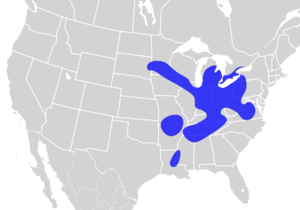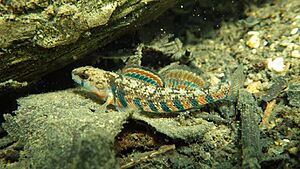Rainbow darter facts for kids
Quick facts for kids Rainbow darter |
|
|---|---|
 |
|
| Conservation status | |
| Scientific classification | |
 |
The rainbow darter (Etheostoma caeruleum) is a small, colorful fish. It lives in fresh water, mostly in streams and small rivers. This fish is part of the family called Percidae, which also includes perches. Rainbow darters are found in North America. They grow to be about 2 to 3 inches (50 to 75 mm) long.
This fish needs very clean water. It is sensitive to pollution and mud. You can easily spot a rainbow darter by the three dark spots on its back. It also has bright blue and orange colors on its fins.
Contents
Life and Appearance
The rainbow darter lives in clean, rocky areas of streams called riffles. These are shallow, fast-moving parts of a river. They usually live for about 4 years. Male rainbow darters can grow up to 48 mm long. Females are a bit smaller, reaching just under 43 mm.
Male darters are very colorful, especially during mating season. They have bright orange and shiny blue spots, stripes, and patterns.
Where Rainbow Darters Live
The rainbow darter is a small fish that lives on the bottom of freshwater creeks and rivers. You can find them in many places across North America. They are very common in the eastern United States. This includes areas around the Great Lakes and the Ohio River Valley. Their home range goes south to northern Alabama and west to Missouri and Arkansas.
Scientists think their distribution is linked to old glaciers. Also, they cannot live in brackish water (water that is a mix of fresh and salt water). This means they stick to purely fresh water. The rainbow darter is one of the most common types of darter fish.
What Rainbow Darters Eat and Their Predators
Rainbow darters are insectivores, meaning they eat insects. They mostly feed on small water creatures like insect larvae and tiny crayfish. They also eat fly larvae. In some streams, they mostly eat caddisflies. They often have two main feeding times: once in the morning and again in the late afternoon or early evening.
Bigger freshwater fish are the main predators of the rainbow darter. These include fish like burbots, stonecats, and smallmouth bass. Like other darters, the rainbow darter can stay in one spot on the bottom of a fast-moving stream. This special ability helps them live in rocky areas with strong currents. They prefer creeks and rivers with rocky bottoms and swift-moving riffles. This preference might be because of the oxygen levels in the water or for finding food and shelter.
Because rainbow darters cannot handle brackish water, pollution from humans can harm them. Things like dirty runoff or sewer water can greatly reduce their numbers.
Reproduction and Life Cycle
Rainbow darters mate in the spring. This usually happens when the water temperature is between 17 and 18 degrees Celsius (63-64°F). They leave their usual fast-moving spots to gather on pebbles where a stream leaves a pool. Here, they choose their mates.
Once a pair is chosen, the fish will mate many times over several days. The female can lay about 800 eggs. Sometimes, many darters will spawn together in a group. During breeding season, male darters often protect their chosen area from other males.
Protecting Rainbow Darters
The biggest danger to rainbow darters today is pollution. This comes from runoff as more people move from rural areas to cities. For example, building a highway can harm fish like the rainbow darter. This happens because it makes the nearby creek water less clean.
To protect these fish, people are working to reduce pollution. This means less nutrients, pesticides, and mud flowing into streams. Experts suggest that conservation plans should check both the physical habitat and the water quality. This combined approach helps fish communities in headwater streams more than just doing one or the other.
Right now, there are no specific plans just for the rainbow darter. However, general plans are in place to protect many rivers, streams, and the fish that live in them.



